The Centennial Case: A Shijima Story review
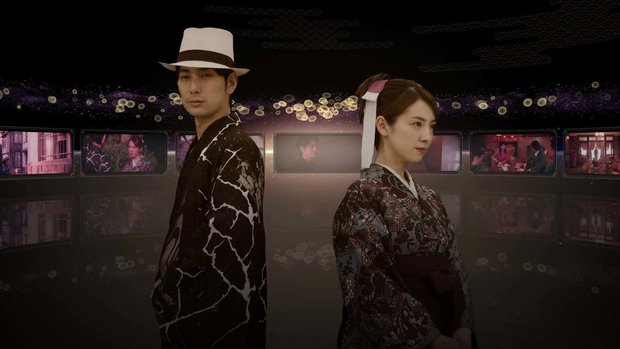
- 2 Comments
You are reading this because of my father.
When I was six or seven, he brought home a couple of games for our IBM. One had us standing in an open field west of a white house, and one had us standing in an open field east of a gray castle (with hungry moat alligators). I was hooked immediately, and solving adventure games with my dad became one of our favorite bonding experiences. We both love a good mystery.
The latest mystery I solved was The Centennial Case: A Shijima Story, the first adventure game by long-time Japanese developer h.a.n.d. (with Square Enix publishing). An FMV mystery, the game finds players investigating a string of murders that have plagued the Shijima family for the past hundred years. Sadly, the otherwise compelling story stalls due to excessive hand-holding, middling performances, and long stretches of tedium.
The Story
My dad is a fantastic storyteller. It doesn’t matter if he’s regaling you with the time he hit a hole-in-one, or simply recalling an anecdote from his trip to the grocery store; he has a trenchant skill of capturing your attention. One of my favorite stories, which I’ve heard at least a dozen times, is about the time some fisherman came to Minnesota to catch our famous walleye. They caught their limit’s worth and asked my dad if he would help clean them. My dad didn’t have the heart to tell them they caught a dozen sheepshead, sending them on their merry way to have a feast of the “poor man’s lobster.” While the story is only mildly amusing on its own, I was captivated each time he told it, perhaps in part because the details changed a little bit each time.
In The Centennial Case, you play as Haruka Kagami, a successful mystery novelist whose science advisor is Eiji Shijima, one of three sons of the present-day Shijima family. He invites Haruka (and her editor, Akari) to his family’s estate at the base of Mt. Fuji to investigate the presence of a hundred-year-old skeleton found on the property. Its presence has disrupted the cherry tree succession ceremony, where the patriarch Ryoei is to determine which son will take over the family’s affairs. Ryoei is initially skeptical of Haruka, especially since he and Eiji have been on the outs for years. But he soon welcomes her, asking her to be a neutral observer (and documentarian) to the succession. After the ceremony, they all gather for tea and Ryoei is summarily poisoned with his first sip.
Along with identifying the culprit behind the poisoning, your investigation will unravel a century-old mystery, not just of the skeleton on the property, but also other accidents and murders that have marked the tragic Shijima family tree. You will focus on just three time periods: 1922, when tragedy first struck at the family estate; 1972, when it began again at a Tokyo nightclub; and present day as everything comes full circle. For over a hundred years, the Shijimas have been obsessed with finding the secret to eternal life, and this pursuit has been a costly one. Even Eiji practically abandoned his family due to this obsession, doing significant research into telomeres, the protective caps on chromosomes that eventually shorten, leaving our body to decay.
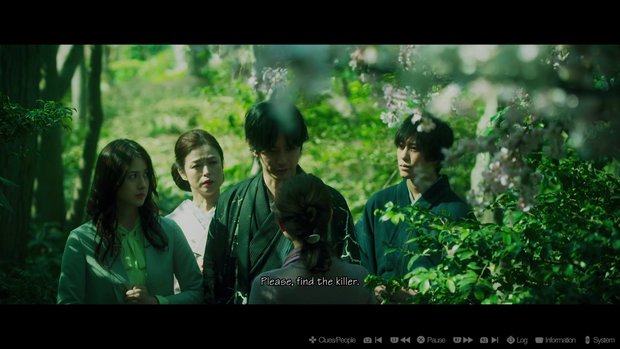
Haruka’s research (in the form of old manuscripts) first leads her to 1922, when the initial prominent murder takes place. As the player, you will be transported back a hundred years to the scene of the crime, watching it play out in real time. A private auction is being held for people to bring artifacts that supposedly promise the fountain of youth, but a murder (and theft) takes place prior to the auction, and you are tasked with solving the case. And by “you,” I mean the young woman from that time period played by the same actress who plays Haruka. She investigates the killing (with your help) and then once you return to the present, the real Haruka will summarize the case to her peers. In fact, nearly all of the characters in every scene across every time period are played by the same group of twelve actors. It’s rationalized by Akari telling Haruka it will help her investigation if she imagines these ghosts of the past as looking like people she already knows. “Pretend it is us,” she says.
While it’s questionable if this actually helps Haruka, it definitely does not help the player. Especially when you meet Ryoei in 1972 as a young man being played by the actor for one of his sons in present day. Keeping track of who’s who is a bear. The game does aid in this by allowing you to scroll through a list of characters (with a picture and short bio) at any point during a scene. It’s helpful, but this mechanic is wholly inadequate when it matters most, as I’ll describe later.
The Deduction
Last year my dad recommended the murder mystery It’s What’s Inside. I felt similarly confused watching that movie, as we got to learn every character before they swapped bodies, so their names no longer matched their original corporeal forms. He couldn’t wait for me to see it so he could compare notes and figure out which of us deduced the murderer sooner. A couple of years before that I had asked him to watch Knives Out for the same reason. What we learned from this exercise is that with or without body swapping, we are both woefully inept at solving murders. All the same, we love a good mystery.
Unfortunately, The Centennial Case goes too far in making investigation extraordinarily simple. In what’s referred to as the “Incident Phase,” each scenario contains thirty minutes to an hour of live-action video (that can blissfully be paused any time by tapping the space bar) during which there is very little to do. Occasionally a character will ask a question and you are given a choice of how to respond, though what you say matters not. As clues appear on the screen, you will be prompted to a press a key to “capture” it. However, even if you don’t partake in this exercise, every clue will still be available to you when it comes time to progress. These brief moments of interactivity are better than nothing, but a large majority of the 15 hours of “play” time are spent doing much of nothing.
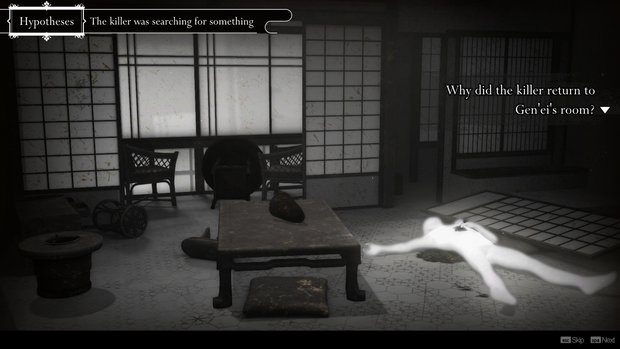
After the investigation portion of the 1922 murder is complete, there are three primary suspects at the auction. You will then enter the “Reasoning Phase” and be presented with a scrolling hexagonal map. On the map are several questions such as: “What was used for the disguise?” You will then need to drag and drop hexagonal clues to the appropriate questions. Even here, though, there is no player agency. Each clue can only fit into one potential slot on the map, so this is merely an exercise in activating what the game wants you to consider as the only available hypotheses. Despite the simplicity, these segments offer the occasional hint on placement if you desire.
When you correctly match a clue to its related question, you will get a cutscene explaining the hypothesis, which will either display an image from a scene you already watched (with some editorializing) or a theoretical CGI enactment of your hypothesis, replete with featureless gray avatars. You will repeat this process for every question presented until you successfully match all of the clues and see all potential answers. This process often takes up to a half hour, and that’s assuming you don’t take more time to rewatch the cutscenes.
After this, Eiji will prompt you to select which aspect of the case is the most intriguing and why. At first this seems pointless, but I discovered over the course of play that Eiji will give subtle hints if he thinks you’re on the right track. While it doesn’t completely give away the answers, if you want to replay this summary section repeatedly, it can go far in helping you solve the case.
Once you decide you’re ready, you will move onto the “Solution Phase.” You then return to the scene of the crime, where our detective will have gathered all of the potential suspects into one room and reveal their deductive reasoning, Hercule Poirot style. This is by far the most (and dare I say only) fun part of the game. Haruka (or her temporal doppelganger) will run through the entire scenario, pausing to give you a chance to deduce which of the hypotheses from the Reasoning Phase are correct. You must successfully pick every true hypothesis in order to reach the end of the scene, with Haruka confidently explaining the details of the crime.
While some hypotheses are clearly ridiculous and easy to avoid, many are based on circumstantial evidence. While that’s to be expected in this type of mystery, at times you need to (correctly) accuse someone who has no apparent motive. To be fair, the game does warn you that you may need to do this at times, but it’s frustrating when your grand conclusion is based on the process of (sometimes flimsy) elimination and not actual evidence.
The only punishment for guessing wrong is having to start that portion of the scene over, which sets you back a mere thirty seconds or so, as you’re allowed to quickly fast-forward (or rewind) any scene. In fact, guessing wrong might be the most entertaining thing you can do, as suspects will point out how ridiculous your erroneous reasoning is, sometime mocking you to the point of embarrassment. A secondary punishment exists of reducing your grade for each scene, which has no effect other than on your own pride. I scored a B on nearly every scenario, which essentially means I got between 80 and 90% of my hypotheses correct the first time.
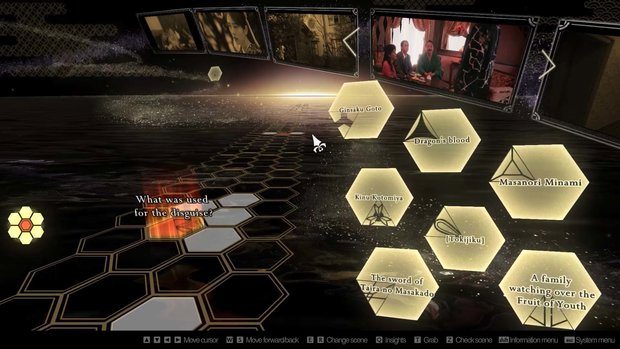
Earlier I mentioned the difficulty of tracking the characters. While you can bring up the bios during the Incident Phase, this is not available to you during the Solution Phase. So if one of your hypotheses involves accusing a specific person, you better remember who everyone is or have a notepad handy to keep track. In one scenario, you’re asked to hypothesize about someone in the past (from a previous chapter). At this point I was completely lost and had to take a wild guess.
Even with all the long stretches of watching movie clips and performing tedious exercises, I think I could have forgiven it had the story been engrossing. While it’s certainly intriguing at times, I found it difficult to care much about everyone’s fates. And I do think a major factor is reusing the same actors for older characters. Not only did I find it confusing, I had a harder time getting invested in the history of the Shijima family. Imagine watching Attack of the Clones, but instead of new actors they had Mark Hamill playing Anakin Skywalker and Harrison Ford playing Obi-Wan Kenobi.
The Performance
One of my dad’s favorite movies is Das Boot, which if I recall is the only non-English film he’s ever watched. I have suggested many, but due to his poor eyesight, he never got used to reading subtitles. So while I have recommended several adventure games to him over the years (including The Walking Dead, which he loved), I knew when I booted up The Centennial Case there was no chance I would be recommending it to him. The English dubbing is brutal; I only listened to it for about five minutes or so, but the timing and tonal match is constantly off.
But I wouldn’t have recommended the game regardless, as the directing and acting leave a lot to be desired as well. The Centennial Case can’t decide if it wants to be campy or serious. One minute, Eiji’s older brother is stomping around and yelling like a cartoon character, and the next minute Eiji’s stepmother is sharing a heartfelt family story while welling up with tears. While a few of the actors give solid, occasionally subtle performances, most of them are not strong enough to evoke any emotions at all. The actress who plays Haruka (and her time-spanning counterparts) frequently over-emotes, in addition to what appears to be anticipating other characters’ lines before they’re spoken. And her “cringe” face when making a mistake looks straight out of a middle school play. I will say, earnestly, that even the poor acting performances are enthusiastic; you can tell everyone’s having fun, which went a long way to keeping me as engaged as I was.
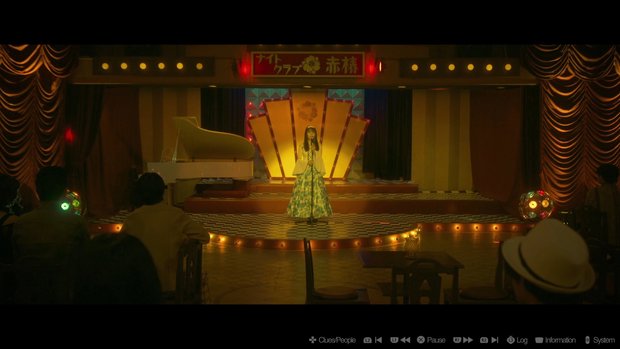
Otherwise the production values are above average for a full-motion video game. An extensive orchestral soundtrack is the highlight, altogether pleasant and rarely intrusive. At no point does a set feel like a set; the Japanese homes feel high-class without being unnecessarily opulent, and the 1972 nightclub has a brooding yet elegant atmosphere. There are many gorgeous scenes shot outdoors in the lush Honshu countryside, including a lantern ceremony. The costume and props departments did a fine job too. I especially appreciated the wide variety of gorgeous kimonos, as well as a dilapidated mummy. I generally felt transported to the appropriate places and times. The only drawback is the cinematography; while there’s some decent work with perspective to accentuate different aspects of a scene, there is a noticeable lack of action shots. More on that in a moment.
The Puzzles
When I was eight years old, my father brought home Police Quest II. Night after night, along with my older brother, we’d huddle around the family computer and problem-solve together. For sure we got Sonny Bonds killed several dozen times, which made overcoming an obstacle all the more satisfying. During the airplane hijack scene, we knew we had to find something to cut the wires of the bomb. I suggested we search the terrorist’s pockets, but that idea was tabled in order to check every single overhead compartment and every single seat. Finally, an hour later, my dad was convinced to check the guy’s pocket. It’s been almost forty years and I’m still gloating about that one. And it inspired me to play every adventure game I could get to chase that same feeling. But it wasn’t just me who kept up the hobby. We all love a good mystery.
Puzzles (outside of making accusations) in The Centennial Case are frustratingly almost non-existent. The story includes a prologue, six chapters, and an epilogue (the latter of similar length to any of the chapters). Every one goes through the same beats as detailed above, with one exception. At one point you need to escape a cell and solve a few adventure game-type puzzles to do so. While you still go through the process of collecting clues and making hypotheses, you will have to manually search for clues (from a first-person perspective, with the ability to freely span 360 degrees) with the mouse and make decisions on how to manipulate items in the room. You even have to deduce where you are on the property, which characters are in what rooms of the house, and then use this information to plan an escape and save someone else. While the few puzzles in this section aren’t terribly difficult, they’re a welcome diversion from what is essentially a fifteen-hour interactive movie.
Now, what could have made this part of the game even cooler? An actual escape scene as we watch our hero follow our plan, going through secret doors, evading our captors, and pulling off the rescue. But no, once the plan is in action, we are just seen casually leaving the property. No doubt there were budgetary restrictions, but come on, Square Enix. You spent about $60 million on Final Fantasy XVI. One decent action scene is not too much to ask.
The End
I wish I could say the ending makes up for the game’s faults. It certainly tries to get us swept up with extraordinary revelations and heartbreaking moments, and a lot of loose ends do get neatly tied up. But in the end, due to my cumulative dissatisfaction with the gameplay to that point, I felt nothing other than relief that my time with the game was over.
The same cannot be said for the story about my dad. I was halfway through The Centennial Case when I got the call. My father had died. Perhaps appropriately, my brother found him in front of his computer, in the same spot we played Zork and King’s Quest and Police Quest four decades ago.
The last time I saw him was two days prior at my home. For a long time now, my children have loved trying to steal his hats. On this particular day, as my dad was leaving, my daughter nabbed his white Panama hat. He was able to retrieve it before taking off. Unbelievably, the next time I booted up The Centennial Case, there was Eiji Shijima, wearing the exact same hat. As a keepsake, my daughter asked for one thing that belonged to her grandpa. I am pleased to say she added his Panama hat to her inventory.
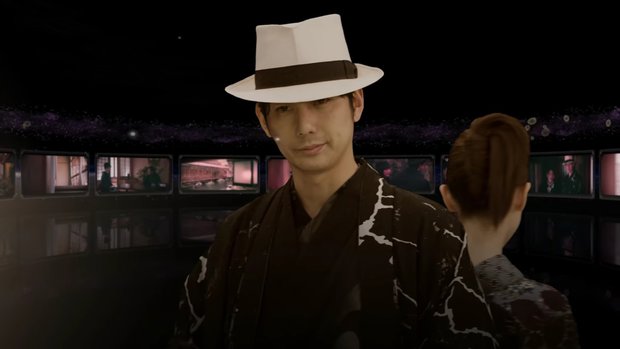
You are reading this because of my father. I wish I could say the game I reviewed in his honor was as amazing as he was. But as a general rule he didn’t sugarcoat, he didn’t let me win, and he didn’t let me off the hook. In that sense, I am doing as he taught me. The Centennial Case: A Shijima Story is an ambitious game with likable characters, a fine production, and some intriguing storylines. So for those who love the FMV genre and don’t mind some passive play and reading subtitles, this might be worth your time. However, the decision to have the same actors play every role is a major misstep, and those who like tightly plotted murder mysteries with hands-on investigating and problem-solving should look elsewhere.
My dad firmly believed that once he died, he would cease to exist and no more adventures would await. I believe that, too. But his adventures live on through me and my children, who occasionally partake in the adventure game genre as well. And, you know, as far as eternal life goes, even he would say who knows. After all, he loves a good mystery.
Hot take
The Centennial Case is one of the more ambitious FMV games in years, telling a century-spanning mystery while putting the player in charge of investigating several whodunits. Unfortunately, despite a solid production, there is very little to engage the player and the uneven acting performances fail to make up for it.
Pros
- Nice variety of intriguing murders to solve
- Likable, enthusiastic cast gives it their all
- Gorgeous visuals complemented by an enjoyable orchestral soundtrack
Cons
- Poor directing and some actors – confusingly and continually recast in new roles – are in over their heads
- Long stretches of watching scenes with virtually no interactivity
- Dearth of puzzle-solving or choices of consequence
Beau played his own copy of The Centennial Case: A Shijima Story on PC.


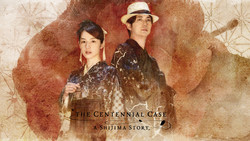








2 Comments
Want to join the discussion? Leave a comment as guest, sign in or register.
Darn, was hoping this would be awesome; on the surface it seems like it'd be a fantastic game to play with my wife. She loves murder mysteries and Asian dramas. Maybe we'll try it anyway --but even though I normally have no problem buying new adventure games at full price on release day, I'll wait 'til this one is on sale. Full price seems like an iffy way to spend fiffy dollars.
Reply
So sorry for your loss, Beau. You worked this into your review masterfully. I also wish it had been a much better gaming experience to link it with.
Reply
Leave a comment